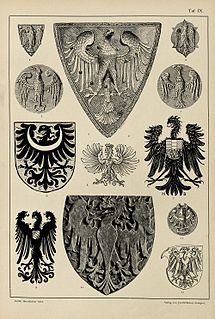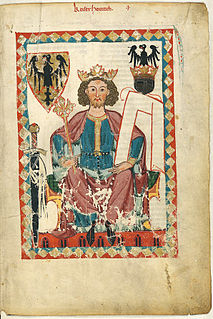 W
WThe eagle is used in heraldry as a charge, as a supporter, and as a crest. Heraldic eagles can be found throughout world history like in the Achaemenid Empire or in the contemporary Republic of Indonesia. The European post-classical symbolism of the heraldic eagle is connected with the Roman Empire on one hand, and with Saint John the Evangelist on the other.
 W
WAn aquila was a prominent symbol used in ancient Rome, especially as the standard of a Roman legion. A legionary known as an aquilifer, the "eagle-bearer", carried this standard. Each legion carried one eagle.
 W
WThe arrano beltza is an ancient Basque and Navarre symbol depicting a black heraldic eagle upon a yellow background. Today, it is mostly used by Basque nationalists as a symbol of sovereignty and independence.
 W
WAvalerion or alerion is a term for a heraldic bird. Historically, it referred to the regular heraldic eagle. Later heralds used the term alerion to refer to "baby eagles" or "eaglets". To differentiate them from mature Eagles, Alerions were shown as an Eagle Displayed Inverted without a beak or claws (disarmed). To difference it from a decapitate (headless) eagle, the Alerion has a bulb-shaped head with an eye staring towards the Dexter of the field. This was later simplified in modern heraldry as an abstract winged oval.
 W
WIn heraldry and vexillology, the double-headed eagle is a charge associated with the concept of Empire. Most modern uses of the symbol are directly or indirectly associated with its use by the Eastern Roman/Byzantine Empire, whose use of it represented the Empire's dominion over the Near East and the West. The symbol is much older, and its original meaning is debated among scholars. The eagle has long been a symbol of power and dominion.
 W
WThe Eagle of Saint John is a heraldic eagle. It is sable, with an or halo and feet of gules.
 W
WThe Eagle of Saladin, in Egypt known as the Egyptian eagle, also known as the Republican Eagle, is a heraldic eagle used as an iconic symbol of Egypt. It is currently also used as part of coat of arms of Egypt, Iraq, and Palestine.
 W
WThe French Imperial Eagle refers to the figure of an eagle on a staff carried into battle as a standard by the Grande Armée of Napoleon during the Napoleonic Wars.
 W
WA Frisian eagle is a specific kind of eagle in Dutch heraldry, consisting of half of a black double-headed eagle on the dexter side of a shield parted per pale.
 W
WMankind has been fascinated by the golden eagle as early as the beginning of recorded history. Most early-recorded cultures regarded the golden eagle with reverence. Only after the Industrial Revolution, when sport-hunting became widespread and commercial stock farming became internationally common, did humans started to widely regard golden eagles as a threat to their livelihoods. This period also brought about the firearm and industrialized poisons, which made it easy for humans to kill the evasive and powerful birds. The following are various reportages of the significance of eagles, many likely pertaining to the golden eagles, in early cultures and older religions as well as national and military insignias.
 W
WThe coat of arms of Poland is a white, crowned eagle with a golden beak and talons, on a red background.
 W
WThe Reichsadler is the heraldic eagle, derived from the Roman eagle standard, used by the Holy Roman Emperors and in modern coats of arms of Germany, including those of the Second German Empire (1871–1918), the Weimar Republic (1919–1933) and Nazi Germany (1933–1945).
 W
WThe Serbian eagle is a double-headed heraldic eagle, a common symbol in the history of Serbian heraldry and vexillology. The double-headed eagle and the Serbian cross are the main heraldic symbols which represent the national identity of the Serbian people across the centuries. It originated from the medieval Nemanjić dynasty. The eagle, defaced with the cross, has been used in the contemporary design of the coat of arms of Serbia following the tradition established by the Kingdom of Serbia in 1882.
 W
WThe three-headed eagle is a mythological or heraldic bird, as it were an augmented version of the double-headed eagle.
 W
WThe stone-carved Zimbabwe Bird is the national emblem of Zimbabwe, appearing on the national flags and coats of arms of both Zimbabwe and Rhodesia, as well as on banknotes and coins. It probably represents the bateleur eagle or the African fish eagle. The bird's design is derived from a number of soapstone sculptures found in the ruins of the ancient city of Great Zimbabwe.